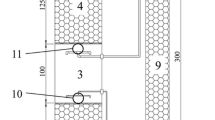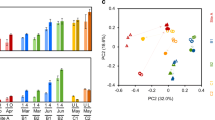Abstract
The main sulfate-reducing (SRB) and sulfur-oxidizing bacteria (SOB) in six wastewater treatment plants (WWTPs) located at southern Brazil were described based on high-throughput sequencing of the 16S rDNA. Specific taxa of SRB and SOB were correlated with some abiotic factors, such as the source of the wastewater, oxygen content, sample type, and physical chemical attributes of these WWTPs. When the 22 families of SRB and SOB were clustered together, the samples presented a striking distribution, demonstrating grouping patterns according to the sample type. For SOB, the most abundant families were Spirochaetaceae, Chromatiaceae, Helicobacteriaceae, Rhodospirillaceae, and Neisseriaceae, whereas, for SRB, were Syntrophaceae, Desulfobacteraceae, Nitrospiraceae, and Desulfovibriaceae. The structure and composition of the major families related to the sulfur cycle were also influenced by six chemical attributes (sulfur, potassium, zinc, manganese, phosphorus, and nitrogen). Sulfur was the chemical attribute that most influenced the variation of bacterial communities in the WWTPs (λ = 0.14, p = 0.008). The OTUs affiliated to Syntrophus showed the highest response to the increase of total sulfur. All these findings can contribute to improve the understanding in relation to the sulfur-oxidizing and sulfate-reducing communities in WWTPs aiming to reduce H2S emissions.




Similar content being viewed by others
References
Andreote FD, Azevedo JL, Araújo WL (2009) Assessing the diversity of bacterial communities associated with plants. Braz J Microbiol 40:417–432. doi:10.1590/s1517-83822009000300001
Arroyo P, Ansola G, Blanco I, Molleda P, Calabuig EL, Sáenez de Miera LE (2010) Comparative analysis of the composition of bacterial communities from two constructed wetlands for municipal and swine wastewater treatment. J Water Health 8:147–157. doi:10.2166/wh.2009.123
Barton LL, Fauque GD (2009) Biochemistry, physiology and biotechnology of sulfate-reducing bacteria. Adv Appl Microbiol 68:41–98. doi:10.1016/s0065-2164(09)01202-7
Belila A, Abbas B, Fazaa I, Saidi N, Snoussi M, Hassen A, Muyzer G (2013) Sulfur bacteria in wastewater stabilization ponds periodically affected by the ‘red-water’ phenomenon. Appl Microbiol Biotechnol 97:379–394. doi:10.1007/s00253-012-3931-5
Bell TH, Callender KL, Whyte LG, Greer CW (2013) Microbial competition in polar soils: a review of an understudied but potentially important control on productivity. Biology 2:533–554. doi:10.3390/biology2020533
Caporaso G, Kuczynski J, Stombaugh J, Bittinger K, Bushman FD, Costello DK, Fierer N, Peña AG, Goodrich JK, Gordon JI, Huttley GA, Kelley ST, Knights D, Koenig JE, Ley RE, Lozupone CA, McDonald D, Muegge BD, Pirrung M, Reeder J, Sevinsky JR, Turnbaugh PJ, Walters WA, Widmann J, Yatsunenko T, Zaneveld J, Knight R (2010) QIIME allows analysis of high-throughput community sequencing data. Nat Methods 7:335–336. doi:10.1038/nmeth.f.303
Comas J, Rodríguez-Roda I, Gernaey KV, Rosen C, Jeppsson U, Poch M (2008) Risk assessment modelling of microbiology-related solids separation problems in activated sludge systems. Environ Model Softw 23:1250–1261. doi:10.1016/j.envsoft.2008.02.013
Daims H (2014) The family Nitrospiraceae. In: Rosenberg E (ed) The prokaryotes. Springer, Berlin, pp. 230–257
de Santis TZ, Hugenholtz P, Larsen N, Rojas M, Brodie EL, Keller K, Huber T, Dalevi D, Hu P, Andersen GL (2006a) Greengenes, a chimera-checked 16 s rRNA gene database and workbench compatible with ARB. Appl Environ Microbiol 72:5069–5072. doi:10.1128/AEM.03006-05
de Santis TZ, Hugenholtz P, Keller K, Brodie EL, Larsen N, Piceno YM, Phan R, Andersen GL (2006b) NAST: a multiple sequence alignment server for comparative analysis of 16 s rRNA genes. Nucleic Acids Res 34:W394–W399. doi:10.1093/nar/gkl244
Di Marzio WD, Sáenz M, Alberdi J, Tortorelli M, Galassi S (2005) Risk assessment of domestic and industrial effluents unloaded into a freshwater environment. Ecotoxicol Environ Safety 61:380–391. doi:10.1016/j.ecoenv.2004.10.002
Edgar RC (2010) Search and clustering orders of magnitude faster than BLAST. Bioinformatics 26:2460–2461. doi:10.1093/bioinformatics/btq461
EMBRAPA (1997) Manual de métodos de análises de solo. Empresa Brasileira de Pesquisa Agropecuária, Rio de Janeiro
Friedrich CG, Bardischewsky F, Rother D, Quentmeier A, Fischer J (2005) Prokaryotic sulfur oxidation. Curr Opin Microbiol 8:253–259. doi:10.1002/9780470015902.a0021155
Ghosh W, Dam B (2009) Biochemistry and molecular biology of lithotrophic sulfur oxidation by taxonomically and ecologically diverse bacteria and archaea. FEMS Microbiol Rev 33:999–1043. doi:10.1111/j.1574-6976.2009.00187.x
Gonzalez-Sanchez A, Alcantara S, Razoflores E, Revah S (2005) Oxygen transfer and consumption in a thiosulfate oxidizing bioreactor with sulfur production. Lett Appl Microbiol 41:141–146. doi:10.1111/j.1472-765X.2005.01741.x
Henze M, Harremoës P, Jansen JC, Arvin E (2002) Wastewater treatment: biological and chemical processes. Springer, Berlin-Heidelberg
Jonkers HM, Koh IO, Behrend P, Muyzer G, de Beer D (2005) Aerobic organic carbon mineralization by sulfate-reducing bacteria in the oxygen-saturated photic zone of a hypersaline microbial mat. Microb Ecol 49:291–300. doi:10.1007/s00248-004-0260-y
Kaksonen A (2004) The performance, kinetics and microbiology of sulfidogenic fluidized-bed reactors treating acidic metal - and sulfate - containing wastewater. Ph.D. thesis. Tampere University of Technology
Kantachote D, Innuwat W (2004) Isolation of Thiobacillus sp. for use in treatment of rubber sheet wastewater. Songklanakarin. J Sci Technol 26:649–657
Kavamura VN, Taketani RG, Lançoni MD, Andreote FD, Mendes R, Melo IS (2013) Water regime influences bulk soil and rhizosphere of Cereus jamacaru bacterial communities in the Brazilian Caatinga biome. PLoS One 8:e73606. doi:10.1371/journal.pone.0073606
Kim TS, Jeong JY, Wells GF, Park HD (2013) General and rare bacterial taxa demonstrating different temporal dynamic patterns in an activated sludge bioreactor. Appl Microbiol Biotechnol 97:1755–1765. doi:10.1007/s00253-012-4002-7
Krishnani KK, Kathiravan V, Natarajan M, Kailasam M, Pillai SM (2010) Diversity of sulfur-oxidizing bacteria in greenwater system of coastal aquaculture. Appl Biochem Biotechnol 162:1225–1237. doi:10.1007/s12010-009-8886-3
Lozupone C, Knight R (2005) UniFrac: a new phylogenetic method for comparing microbial communities. Appl Environ Microbiol 71:8228–8235. doi:10.1128/AEM.71.12.8228-8235.2005
Luo JF, Lin WT, Guo Y (2011) Functional genes based analysis of sulfur-oxidizing bacteria community in sulfide removing bioreactor. Appl Microbiol Biotechnol 90:769–778. doi:10.1007/s00253-010-3061-x
Meyer B, Kuever J (2007) Molecular analysis of the distribution and phylogeny of dissimilatory adenosine-5′-phosphosulfate reductase-encoding genes (aprBA) among sulfur-oxidizing prokaryotes. Microbiology 153:3478–3498. doi:10.1099/mic.0.2007/008250-0
Meyer B, Imhoff JF, Kuever J (2007) Molecular analysis of the distribution and phylogeny of the soxB gene among sulfur-oxidizing bacteria - evolution of the Sox sulfur oxidation enzyme system. Environ Microbiol 9:2957–2977. doi:10.1111/j.1462-2920.2007.01407.x
Mohanakrishnan J, Kofoed MV, Barr J, Yuan Z, Schramm A, Meyer RL (2011) Dynamic microbial response of sulfidogenic wastewater biofilm to nitrate. Appl Microbiol Biotechnol 91:1647–1657. doi:10.1007/s00253-011-3330-3
Muyzer G, Stams AJM (2008) The ecology and biotechnology of sulphate-reducing bacteria. Nature. Microbiol Rev 6:441–454. doi:10.1038/nrmicro1892
Pokorna D, Zabranska J (2015) Sulfur-oxidizing bacteria in environmental technology. Biotechnol Adv 33:1246–1259. doi:10.1016/j.biotechadv.2015.02.007
Rattanapan C, Boonsawang P, Kantachote D (2009) Removal of H2S in down-flow GAC biofiltration using sulfide oxidizing bacteria from concentrated latex wastewater. Bioresource Technol 100:125–130. doi:10.1016/j.biortech.2008.05.049
Sigalevich P, Cohen Y (2000) Oxygen-dependent growth of the sulfate-reducing bacterium Desulfovibrio oxyclinae in coculture with Marinobacter sp strain MB in an aerated sulfate-depleted chemostat. Appl Environ Microbiol 66:5019–5023. doi:10.1128/AEM.66.11.5019-5023.2000
Sogin ML, Morrison HG, Huber JA, Welch DM, Huse SM, Neal PR, Arrieta JM, Herndl GJ (2006) Microbial diversity in the deep sea and the underexplored “rare biosphere. Proc Natl Acad Sci U S A 106:12115–12120. doi:10.1073/pnas.0605127103
Sparks DL, Page AL, Helmke PA, Loeppert RH (1996) Methods of soil analysis part 3—chemical methods. American Society of Agronomy, Madison, WI. doi:10.2136/sssabookser5.3
Tourova TP, Slobodova NV, Bumazhkin BK, Kolganova TV, Muyza G, Sorokin DY (2013) Analysis of community of sulfur-oxidizing bacteria in hypersaline and soda lakes using soxB as a functional molecular market. FEMS Microbiol Ecol 84:280–289. doi:10.1111/1574-6941.12056
Varón-Lopez M, Dias ACF, Fasanella CC, Durrer A, Melo IS, Kuramae EE, Andreote FD (2014) Sulphur-oxidizing and sulphate-reducing communities in Brazilian mangrove sediments. Environ Microbiol 16:845–855. doi:10.1111/1462-2920.12237
Vazquez-Baeza Y, Pirrung M, Gonzalez A, Knight R (2013) Emperor: a tool for visualizing high-throughput microbial community data. GigaScience 2:1–16. doi:10.1186/2047-217X-2-16
Vidyalakshmi R, Paranthaman R, Bhakyaraj R (2009) Sulphur oxidizing bacteria and pulse nutrition: a review. World J Agric Sci 5:270–278
Wang Q, Garrity GM, Tiedje JM, Cole JR (2007) Naïve bayesian classifier for rapid assignment of rRNA sequences into the new bacterial taxonomy. Appl Environ Microbiol 73:5261–5267. doi:10.1128/AEM.00062-07
Xia S, Duan L, Song Y, Li J, Piceno MY, Andersen GL, Alvarez-Cohen L, Moreno-Andrade I, Huang CL, Hermanowicz SW (2010) Bacterial community structure in geographically distributed biological wastewater treatment reactors. Environ Sci Technol 44:7391–7396. doi:10.1021/es101554m
Ye L, Zhang T (2013) Bacterial communities in different sections of a municipal wastewater treatment plant revealed by 16S rDNA 454 pyrosequencing. Appl Microbiol Biotechnol 97:2681–2690. doi:10.1007/s00253-012-4082-4
Zhang L, de Schryver P, de Gusseme B, de Muynck W, Boon N, Verstraete W (2007) Chemical and biological technologies for hydrogen sulfide emission control in sewer: a review. Water Res 42:1–12. doi:10.1016/j.watres.2007.07.013
Acknowledgments
The authors thank CAPES for awarding the research grant to D.D. Meyer and FAPESP for providing financial resources for the development of this research.
Author information
Authors and Affiliations
Corresponding author
Ethics declarations
Conflict of interest
The authors declare that they have no conflict of interest.
Ethical approval
This article does not contain any studies with human participants or animals performed by any of the authors.
Rights and permissions
About this article
Cite this article
Meyer, D.D., de Andrade, P.A.M., Durrer, A. et al. Bacterial communities involved in sulfur transformations in wastewater treatment plants. Appl Microbiol Biotechnol 100, 10125–10135 (2016). https://doi.org/10.1007/s00253-016-7839-3
Received:
Revised:
Accepted:
Published:
Issue Date:
DOI: https://doi.org/10.1007/s00253-016-7839-3




